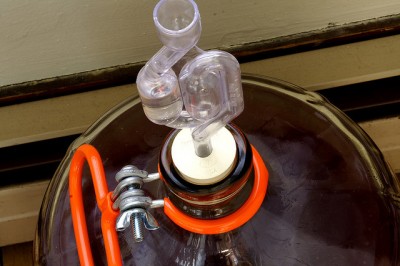What Is Fermentation?
The short version is that fermentation is the yeast turning your wort into beer. Depending on the style of the beer, the ingredients and the alcohol level, fermenting can last from a week to a year (not to scare you, most beers are 2-4 weeks). The cool part is that you don’t have to do anything, you just get to sit back and relax as the yeast do their work.
For best results, you need to use a hydrometer and take a gravity reading before you add the yeast to your wort. That’ll be you’re starting point and hopefully is close to matching the original gravity (OG) for your recipe. When the airlock is no longer bubbling, you’re going to want to take another reading to find out the new gravity reading. If the gravity number stays steady for a few days, your yeast are done working and it’s time to move on to the next step – a secondary fermenter, bottling, etc.
Where Should I Store My Beer When It’s Fermenting?
For beginning/extract brewers, you should store your future beer in a fermenting bucket or carboy. You can find both of these at a homebrew shop locally or online (my link to Midwest Supplies, my favorite supply shop).
Now you could leave your fermenting bucket on the kitchen counter, but I wouldn’t recommend that for a number of reasons. First of all, I’m sure you’re significant other wouldn’t appreciate that!
But in all seriousness, the best place to keep your beer is some place dark like a closet or basement. Light damages beer, so let’s keep it in a dark spot.
If you’re just starting out, you can just put it in the closet and forget about it. However, if you live in a cold or warm climate, there’s some other things you should consider.
If you live where it’s cold, you don’t want to store it some place so cold that it slows down the yeast or even worse puts the yeast to sleep. I’ve even read about homebrewers that froze their wort because they weren’t paying attention to the temperature. You can buy things to keep your yeast warm, if you do have to store it some place cold.
If you live some place hot, say like Tampa, Florida (like me), you’re going to have to make sure that your yeast don’t get too hot and produce off flavors or even worse kill them. You can start with a swamp cooler. However, it wasn’t long before I upgraded to a chest freezer with a temperature controller so that I could control the temperature.
What Temperature Should My Beer Ferment At?
Okay, so too hot or too cold is going to give my beer off flavors or even ruin it, how do I know which temperature I should have my beer at?
The answer is that it varies depending on the yeast. Luckily, it’ll usually tell you on yeast package or the recipe what temperature range to shoot for.
As a general rule, ales ferment between 60-70 degrees Fahrenheit. Lagers like between 50 and 60 degrees.
What advice do you have for a new brewer that wants to make sure fermentation happens without any hitches?
—
Photo by timothy.holt.
